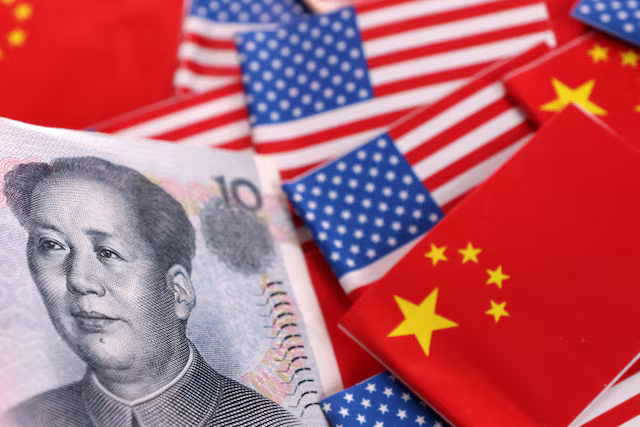As the US-China trade war intensifies, financial markets are increasingly speculating that China may consider devaluing the yuan against the dollar.
This would mark a significant shift from the country’s long-standing policy of maintaining a stable currency, raising concerns about its potential impact on the global economy.
China’s response to US tariffs, which have grown more severe following President Trump’s recent measures, is sparking debate among strategists about whether Beijing might allow the yuan to weaken sharply. This move, while potentially making Chinese exports more competitive, could also provoke capital flight and undermine investor confidence. On Friday, Chinese officials issued a strong warning of a “resolute” response to President Trump’s tariffs, which include a 34% duty on all US imports set to take effect on April 10.
Financial analysts are weighing the risks of a deliberate depreciation of the yuan, with some forecasting potential moves of up to 15% over the next two months. Wells Fargo & Co. has noted the possibility of a 15% depreciation, while Jefferies Financial Group has suggested that China could opt for a more aggressive devaluation of up to 30%. Mizuho Financial Group is taking a more cautious approach, predicting a 3% weakening to around 7.5 yuan per dollar.
Aroop Chatterjee, a strategist at Wells Fargo, emphasized that such a currency move could directly address China’s loss of competitiveness due to the tariffs, thus making the yuan a powerful tool in retaliation. However, this approach carries risks, as China’s history with currency devaluation has been tumultuous, notably the 2015 shock that led to significant market turmoil.
For years, China has prioritized maintaining a stable yuan, both to foster global trade relationships and to support its ambitions for the internationalization of its currency. This policy has often involved carefully controlling the yuan’s fluctuations to avoid disruptions in both domestic and international markets. Yet, the latest round of tariffs, which include a significant 54% tariff increase since the start of Trump’s second term, may prompt a reevaluation of this approach.
A devaluation could help mitigate some of the tariff impacts by making Chinese goods cheaper abroad, but it would also risk exacerbating the economic slowdown already affecting the country. The People’s Bank of China (PBOC) has already signaled a looser grip on the yuan with its daily reference rate, setting it at its weakest level since December, just below the critical 7.20 per dollar mark. On Monday, the onshore yuan fell as much as 0.5%, reaching its lowest point since January, while China’s stock market also faced significant declines.
Some market experts, such as Robin Brooks from the Brookings Institution, have suggested that the yuan could become a “potent weapon” for China in the trade war. However, any aggressive devaluation would be risky, especially given the potential for capital flight. In 2015, a similar move led to a loss of confidence in China’s ability to manage its markets, with far-reaching effects on global securities.
In response to the growing uncertainty, Beijing may look to follow its 2018 playbook, which allowed for a weaker currency but in a controlled manner designed to prevent speculative attacks. Such a strategy would likely aim to avoid the chaotic depreciation seen in 2015 while still providing some relief from the economic strain caused by US tariffs.
Ray Dalio, founder of Bridgewater Associates, has suggested that China could consider negotiating a deal to strengthen the yuan in exchange for tariff relief. However, most analysts believe this is unlikely, given that Chinese officials are wary of the long-term economic consequences of agreeing to such an arrangement, especially given the historical context of the 1985 Plaza Accord, which led to Japan’s prolonged economic difficulties.










The latest news in your social feeds
Subscribe to our social media platforms to stay tuned